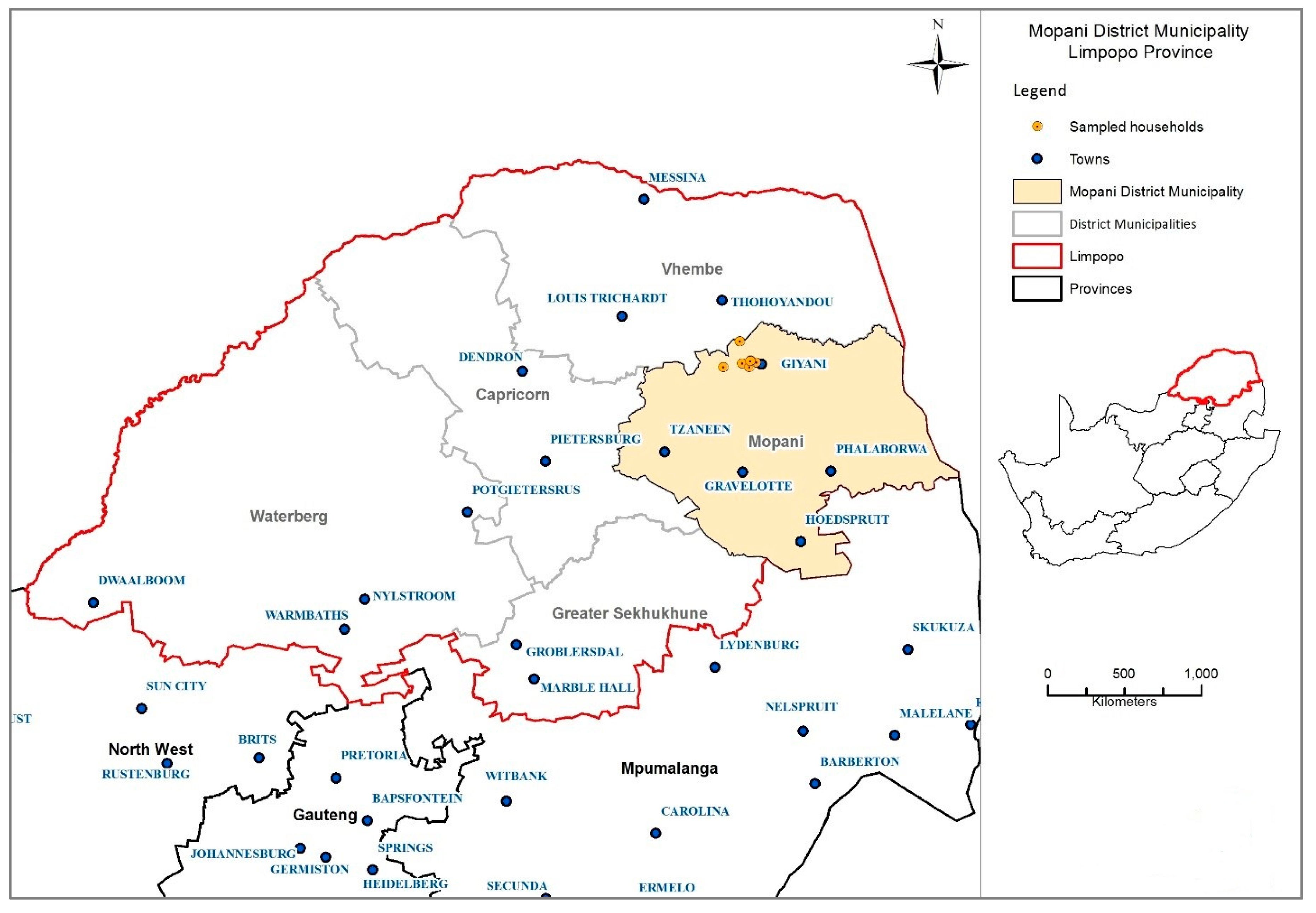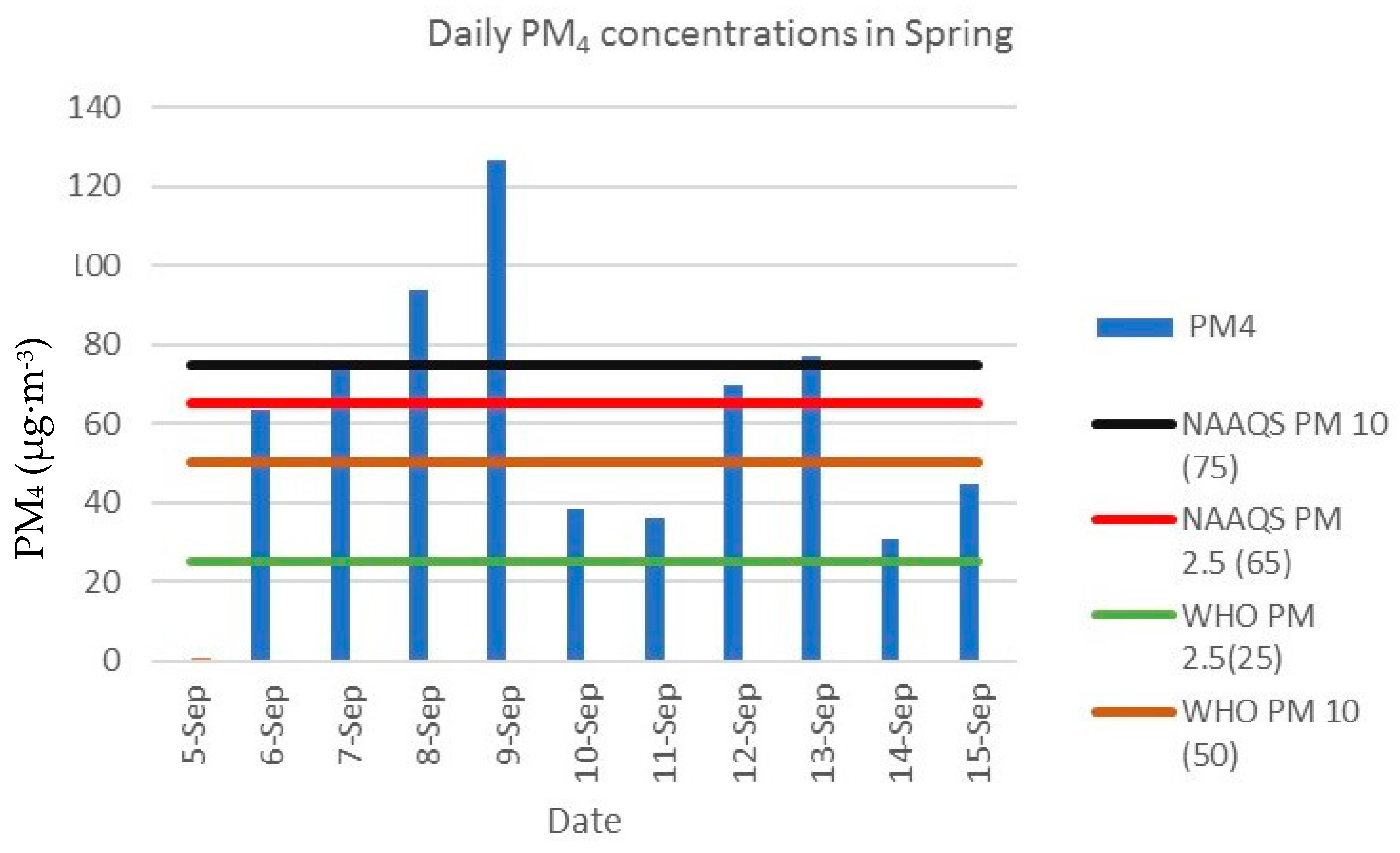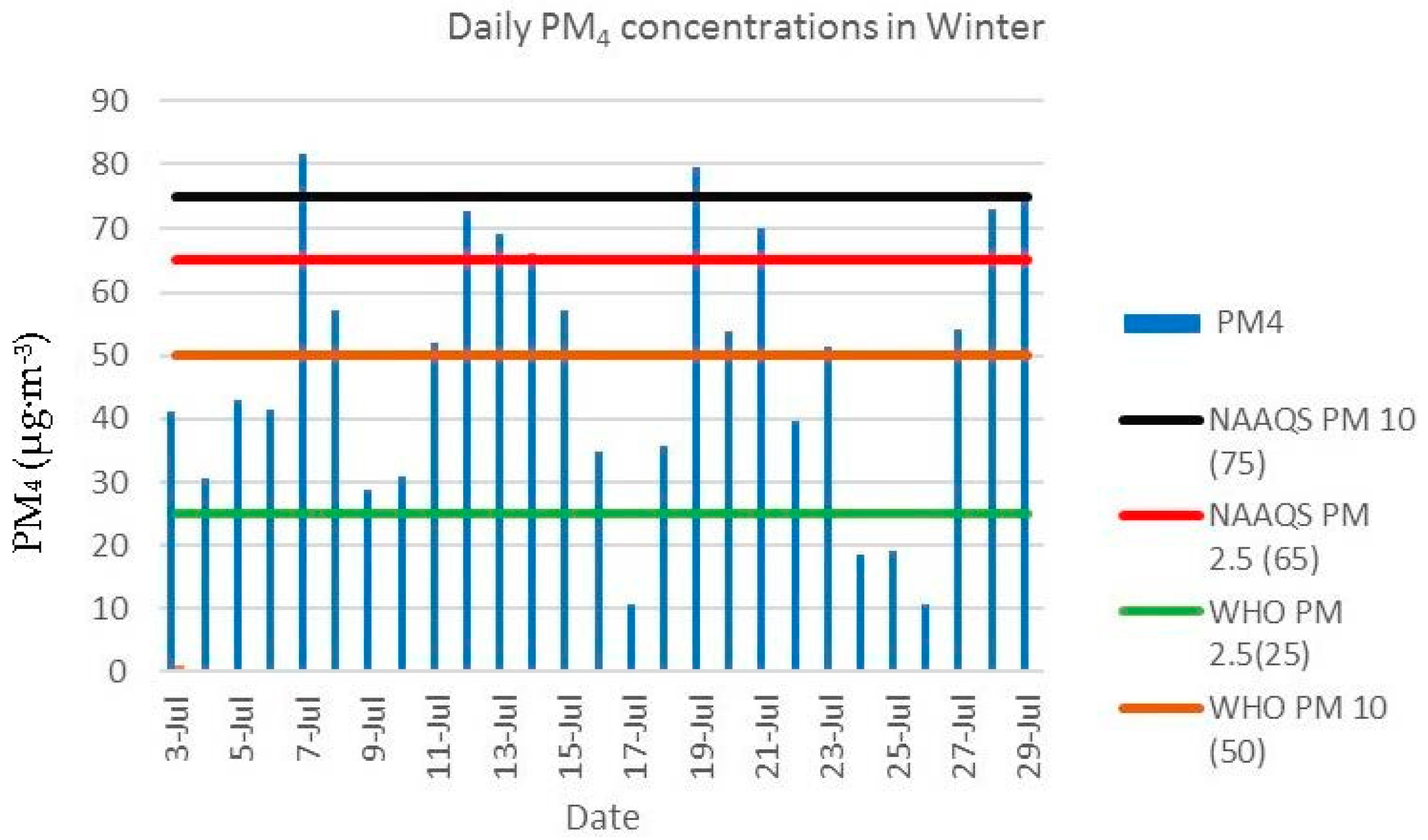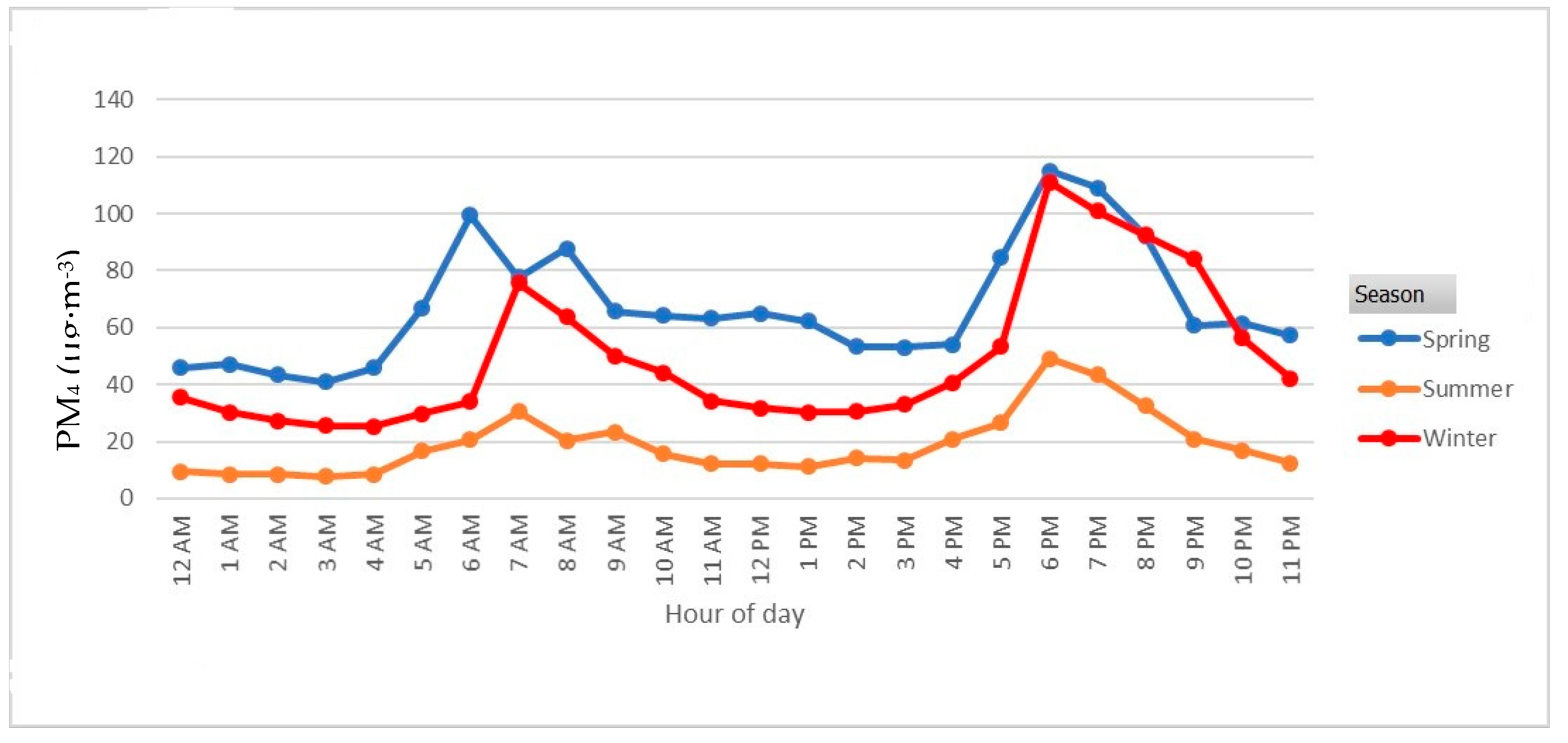Variation of Indoor Particulate Matter Concentrations and Association with Indoor/Outdoor Temperature: A Case Study in Rural Limpopo, South Africa
Abstract
:1. Introduction
2. Materials and Methods
2.1. Study Site
2.2. Household Questionnaire
2.3. Physical Indoor Air Quality Monitoring
2.4. Indoor and Outdoor Temperature Measurements
2.5. Household Characteristics
2.6. Data Analysis
3. Results
3.1. Seasonal Variation of Indoor Air Quality and Indoor and Outdoor Meteorological Variables
Correlation Analysis
3.2. Time Series Analysis
Diurnal Variation
4. Discussion
5. Conclusions
Acknowledgments
Author Contributions
Conflicts of Interest
Declarations
Appendix A
| N = 7 | |
| Question | Count of responses |
| How many people including you make up this main household? | |
| 4–6 | 5 |
| 6–8 | 2 |
| >8 | - |
| How many children under the age of 5 are part of this household? | |
| 0 | 4 |
| 1–3 | 3 |
| >3 | - |
| How many people over the age of 60 are part of this household? | |
| 0 | 3 |
| 1–3 | 4 |
| >3 | - |
| During very cold weather, do you use any of the following systems to heat your home? | |
| Wood or coal stove | 4 |
| Fireplace | 3 |
| Gas | - |
| Electric heater | 1 |
| Paraffin heater | 0 |
| How often do you use the wood/coal stove? | |
| About everyday | 4 |
| 2–3 times a week | |
| 2–3 times a month | |
| Seldom | |
| Never | |
| How often do you use the fireplace? | |
| About everyday | 3 |
| 2–3 times a week | |
| 2–3 times a month | |
| Seldom | |
| Never | |
| How often do you use the electric heater | |
| About everyday | |
| 2–3 times a week | |
| 2–3 times a month | 1 |
| Seldom | |
| Never | |
| What fuel do you mainly use for cooking? | |
| Electricity | 2 |
| Paraffin | |
| Gas | |
| Wood | 5 |
| Coal | |
| Crop waste/cow dung | |
| Does the family sit in the same room around the stove or cooking fire–when cooking is taking place? | |
| Yes | |
| No | 7 |
| Please specify when fires are made? | |
| Morning | 6 |
| Midday | |
| Evening | 4 |
| Where do you do your daily cooking? | |
| kitchen (part of the house) | 1 |
| kitchen (separated from the house) | 6 |
| Do you have any dampness in the dwelling? | |
| No | 7 |
| Yes | 0 |
| Do you have any leaks in the roof or leaking water pipes in or around the dwelling? | |
| No | 7 |
| Yes | 0 |
References
- Perez-Padilla, R.; Schilmann, A.; Riojas-Rodriguez, H. Respiratory health effects of indoor air pollution. Int. J. Tuberc. Lung Dis. 2010, 14, 1079–1086. [Google Scholar] [PubMed]
- Naeher, L.P.; Brauer, M.; Lipsett, M.; Zelikoff, J.T.; Simpson, C.D.; Koenig, J.Q.; Smith, K.R. Woodsmoke health effects: A review. Inhal. Toxicol. 2007, 19, 67–106. [Google Scholar] [CrossRef] [PubMed]
- Fullerton, D.G.; Bruce, N.; Gordon, S.B. Indoor air pollution from biomass fuel smoke is a major health concern in the developing world. Trans. R. Soc. Trop. Med. Hyg. 2008, 102, 843–851. [Google Scholar] [CrossRef] [PubMed]
- Barnes, B.; Mathee, A.; Thomas, E.; Bruce, N. Household energy, indoor air pollution and child respiratory health in South Africa. J. Energy South Afr. 2009, 20, 4–13. [Google Scholar]
- Araujo, J.A.; Nel, A.E. Particulate matter and atherosclerosis: Role of particle size, composition and oxidative stress. Part. Fibre Toxicol. 2009, 6, 1. [Google Scholar] [CrossRef] [PubMed]
- EPA, Office of Air Quality Planning and Standards. Review of the National Ambient Air Quality Standards for Particulate Matter: Policy Assessment of Scientific and Technical Information. 2005. Available online: https://www.google.com.sg/url?sa=t&rct=j&q=&esrc=s&source=web&cd=1&ved=0ahUKEwiww5Cqz73ZAhUCTrwKHSIrDUoQFggnMAA&url=https%3A%2F%2Fepa.gov%2Fttn%2Fnaaqs%2Fstandards%2Fpm%2Fdata%2F1996pmstaffpaper.pdf&usg=AOvVaw0OyaIWWGEVUL0Z-spJ2KHg (accessed on 15 January 2018).
- Megaritis, A.; Fountoukis, C.; Charalampidis, P.; Pilinis, C.; Pandis, S.N. Response of fine particulate matter concentrations to changes of emissions and temperature in europe. Atmos. Chem. Phys. 2013, 13, 3423–3443. [Google Scholar] [CrossRef]
- Semmens, E.O.; Noonan, C.W.; Allen, R.W.; Weiler, E.C.; Ward, T.J. Indoor particulate matter in rural, wood stove heated homes. Environ. Res. 2015, 138, 93–100. [Google Scholar] [CrossRef] [PubMed]
- Paulin, L.M.; Williams, D.A.; Oberweiser, C.; Diette, G.B.; Breysse, P.N.; McCormack, M.M.; Matsui, E.C.; Peng, R.; Metts, T.A.; Hansel, N.N. Indoor air quality in central appalachia homes impacted by wood and coal use. J. Environ. Prot. 2013, 4, 67. [Google Scholar] [CrossRef] [PubMed]
- Salvi, S.; Barnes, P.J. Is exposure to biomass smoke the biggest risk factor for COPD globally? Chest 2010, 138, 3–6. [Google Scholar] [CrossRef] [PubMed]
- Frontczak, M.; Wargocki, P. Literature survey on how different factors influence human comfort in indoor environments. Build. Environ. 2011, 46, 922–937. [Google Scholar] [CrossRef]
- Kim, J.Y.; Magari, S.R.; Herrick, R.F.; Smith, T.J.; Christiani, D.C.; Christiani, D.C. Comparison of fine particle measurements from a direct-reading instrument and a gravimetric sampling method. J. Occup. Environ. Hyg. 2004, 1, 707–715. [Google Scholar] [CrossRef] [PubMed]
- Inc, T. Sidepak Personal Aerosol Monitor Model AM510: User Guide. 2002. Available online: https://www.google.com.sg/url?sa=t&rct=j&q=&esrc=s&source=web&cd=1&ved=0ahUKEwjR3PvM1r3ZAhWMvbwKHRutBucQFggnMAA&url=http%3A%2F%2Fwww.tsi.com%2FuploadedFiles%2F_Site_Root%2FProducts%2FLiterature%2FManuals%2FSidePak_AIM510_US_1980456-web.pdf&usg=AOvVaw0GTsN7Azqoy-vjfoarg40R (accessed on 17 November 2017).
- Tung, T.C.; Chao, C.Y.; Burnett, J. A methodology to investigate the particulate penetration coefficient through building shell. Atmos. Environ. 1999, 33, 881–893. [Google Scholar] [CrossRef]
- Heal, M.R.; Beverland, I.J.; McCabe, M.; Hepburn, W.; Agius, R.M. Intercomparison of five PM10 monitoring devices and the implications for exposure measurement in epidemiological research. J. Environ. Monit. 2000, 2, 455–461. [Google Scholar] [CrossRef] [PubMed]
- Ramachandran, G.; Adgate, J.L.; Hill, N.; Sexton, K.; Pratt, G.C.; Bock, D. Comparison of short-term variations (15-minute averages) in outdoor and indoor PM2.5 concentrations. J. Air Waste Manag. Assoc. 2000, 50, 1157–1166. [Google Scholar] [CrossRef] [PubMed]
- Chung, A.; Chang, D.P.; Kleeman, M.J.; Perry, K.D.; Cahill, T.A.; Dutcher, D.; McDougall, E.M.; Stroud, K. Comparison of real-time instruments used to monitor airborne particulate matter. J. Air Waste Manag. Assoc. 2001, 51, 109–120. [Google Scholar] [CrossRef] [PubMed]
- Yanosky, J.D.; Williams, P.L.; MacIntosh, D.L. A comparison of two direct-reading aerosol monitors with the federal reference method for PM2.5 in indoor air. Atmos. Environ. 2002, 36, 107–113. [Google Scholar] [CrossRef]
- Braniš, M.; Hovorka, J. Performance of a photometer DustTrak in various indoor and outdoor environments. In Proceedings of the Evaluations and Assessment Conference, Ghent, Belgium, 28 Septemper–10 October 2005; p. 535. [Google Scholar]
- Kingham, S.; Durand, M.; Aberkane, T.; Harrison, J.; Wilson, J.G.; Epton, M. Winter comparison of TEOM, minivol and dusttrak PM10 monitors in a woodsmoke environment. Atmos. Environ. 2006, 40, 338–347. [Google Scholar] [CrossRef]
- McNamara, M.L.; Noonan, C.W.; Ward, T.J. Correction factor for continuous monitoring of wood smoke fine particulate matter. Aerosol Air Qual. Res. 2011, 11, 315. [Google Scholar] [CrossRef] [PubMed]
- Wallace, L.A.; Wheeler, A.J.; Kearney, J.; Van Ryswyk, K.; You, H.; Kulka, R.H.; Rasmussen, P.E.; Brook, J.R.; Xu, X. Validation of continuous particle monitors for personal, indoor, and outdoor exposures. J. Exposure Sci. Environ. Epidemiol. 2011, 21, 49–64. [Google Scholar] [CrossRef] [PubMed]
- Nitschke, M.; Tucker, G.R.; Hansen, A.L.; Williams, S.; Zhang, Y.; Bi, P. Impact of two recent extreme heat episodes on morbidity and mortality in Adelaide, South Australia: A case-series analysis. Environ. Health 2011, 10, 42. [Google Scholar] [CrossRef] [PubMed]
- Bai, L.; Ding, G.; Gu, S.; Bi, P.; Su, B.; Qin, D.; Xu, G.; Liu, Q. The effects of summer temperature and heat waves on heat-related illness in a coastal city of China, 2011–2013. Environ. Res. 2014, 132, 212–219. [Google Scholar] [CrossRef] [PubMed]
- Garland, R.M.; Horowitz, H.M.; Engelbrecht, C.J.; Dedekind, Z.; Bopape, M.-J.M.; Engelbrecht, F.A. Representation of aerosol particles and associated transport pathways in regional climate modelling in Africa. In Proceedings of the 32nd Annual Conference of the South African Society for Atmospheric Sciences, Cape Town, South Africa, 31 October–1 November 2016. [Google Scholar]
- Jung, K.H.; Patel, M.M.; Moors, K.; Kinney, P.L.; Chillrud, S.N.; Whyatt, R.; Hoepner, L.; Garfinkel, R.; Yan, B.; Ross, J. Effects of heating season on residential indoor and outdoor polycyclic aromatic hydrocarbons, black carbon, and particulate matter in an urban birth cohort. Atmos. Environ. 2010, 44, 4545–4552. [Google Scholar] [CrossRef] [PubMed]
- Vilčeková, S.; Apostoloski, I.Z.; Mečiarová, L.; Burdová, E.K.; Kiseľák, J. Investigation of indoor air quality in houses of macedonia. Int. J. Environ. Res. Public Health 2017, 14, 37. [Google Scholar] [CrossRef] [PubMed]
- Department of Environmental Affairs. National Environmental Management: Air Quality Act, 2004 (Act No. 39 of 2004). National Ambient Air Quality Standards. Available online: https://www.environment.gov.za/sites/default/files/legislations/nemaqa_airquality_g32816gon1210.pdf (accessed on 22 January 2018).
- Department of Environmental Affairs. National Environmental Management: Air Quality Act, 2004 (Act No. 39 of 2004) No. 354637 29 June 2012 National Ambient Air Quality Standard for Particulate Matter with Aerodynamic Diameter Less than 2.5 Micron Metres (PM2.5). Available online: https://cer.org.za/wp-content/uploads/2010/03/National-Ambient-Air-Quality-Standard_PM2.5.pdf (accessed on 22 January 2018).
- World Health Organization. WHO Air Quality Guidelines: Global Update 2005: Particulate matter, Ozone, Nitrogen Dioxide, and Sulfur Dioxide. Available online: http://apps.who.int/iris/bitstream/10665/69477/1/WHO_SDE_PHE_OEH_06.02_eng.pdf (accessed on 25 November 2017).
- Brown, J.S.; Gordon, T.; Price, O.; Asgharian, B. Thoracic and respirable particle definitions for human health risk assessment. Part. Fibre Toxicol. 2013, 10, 12. [Google Scholar] [CrossRef] [PubMed]
- Hazard Prevention and Control in the Work Environment: Airborne Dust. Available online: Http://www.Who.Int/occupational_health/publications/en/oehairbornedust3.Pdf (accessed on 10 January 2018).
- Bernstein, J.A.; Alexis, N.; Bacchus, H.; Bernstein, I.L.; Fritz, P.; Horner, E.; Li, N.; Mason, S.; Nel, A.; Oullette, J. The health effects of nonindustrial indoor air pollution. J. Allergy Clin. Immunol. Pract. 2008, 121, 585–591. [Google Scholar] [CrossRef] [PubMed]
- Kaplan, C. Indoor air pollution from unprocessed solid fuels in developing countries. Rev. Environ. Health 2010, 25, 221–242. [Google Scholar] [CrossRef] [PubMed]
- Oluwole, O.; Otaniyi, O.O.; Ana, G.A.; Olopade, C.O. Indoor air pollution from biomass fuels: A major health hazard in developing countries. J. Public Health 2012, 20, 565–575. [Google Scholar] [CrossRef]
- Ezzati, M.; Kammen, D.M. Indoor air pollution from biomass combustion and acute respiratory infections in Kenya: An exposure-response study. Lancet 2001, 358, 619–624. [Google Scholar] [CrossRef]
- Tai, A.P.; Mickley, L.J.; Jacob, D.J. Correlations between fine particulate matter (PM2.5) and meteorological variables in the United States: Implications for the sensitivity of PM2.5 to climate change. Atmos. Environ. 2010, 44, 3976–3984. [Google Scholar] [CrossRef]
- Massey, D.; Kulshrestha, A.; Masih, J.; Taneja, A. Seasonal trends of PM10, PM5.0, PM2.5 & PM10 in indoor and outdoor environments of residential homes located in north-central India. Build. Environ. 2012, 47, 223–231. [Google Scholar]
- Dawson, J.; Adams, P.; Pandis, S. Sensitivity of PM2.5 to climate in the Eastern Us: A modeling case study. Atmos. Chem. Phys. 2007, 7, 4295–4309. [Google Scholar] [CrossRef]
- Liu, Z.; Hu, B.; Wang, L.; Wu, F.; Gao, W.; Wang, Y. Seasonal and diurnal variation in particulate matter (PM10 and PM2.5) at an urban site of Beijing: Analyses from a 9-year study. Environ. Sci. Pollut. Res. 2015, 22, 627–642. [Google Scholar] [CrossRef] [PubMed]
- Van Donkelaar, A.; Martin, R.V.; Brauer, M.; Kahn, R.; Levy, R.; Verduzco, C.; Villeneuve, P.J. Global estimates of ambient fine particulate matter concentrations from satellite-based aerosol optical depth: Development and application. Environ. Health Perspect. 2010, 118, 847. [Google Scholar] [CrossRef] [PubMed]
- Fromme, H.; Twardella, D.; Dietrich, S.; Heitmann, D.; Schierl, R.; Liebl, B.; Rüden, H. Particulate matter in the indoor air of classrooms—exploratory results from munich and surrounding area. Atmos. Environ. 2007, 41, 854–866. [Google Scholar] [CrossRef]
- Litvak, A.; Gadgil, A.; Fisk, W. Hygroscopic fine mode particle deposition on electronic circuitsand resulting degradation of circuit performance: An experimentalstudy. Indoor Air 2000, 10, 47–56. [Google Scholar] [CrossRef] [PubMed]
- Miguel, A.F.; Reis, A.H.; Aydin, M. Aerosol particle deposition and distribution in bifurcating ventilation ducts. J. Hazard Mater. 2004, 116, 249–255. [Google Scholar] [CrossRef] [PubMed]
- Gurley, E.S.; Salje, H.; Homaira, N.; Ram, P.K.; Haque, R.; Petri, W.A.; Bresee, J.; Moss, W.J.; Luby, S.P.; Breysse, P. Seasonal concentrations and determinants of indoor particulate matter in a low-income community in Dhaka, Bangladesh. Environ. Res. 2013, 121, 11–16. [Google Scholar] [CrossRef] [PubMed]
- Wheeler, A.J.; Wallace, L.A.; Kearney, J.; Van Ryswyk, K.; You, H.; Kulka, R.; Brook, J.R.; Xu, X. Personal, indoor, and outdoor concentrations of fine and ultrafine particles using continuous monitors in multiple residences. Aerosol Sci. Technol. 2011, 45, 1078–1089. [Google Scholar] [CrossRef]
- Karar, K.; Gupta, A.; Kumar, A.; Biswas, A.K. Seasonal variations of PM10 and TSP in residential and industrial sites in an urban area of kolkata, India. Environ. Monit. Assess. 2006, 118, 369–381. [Google Scholar] [CrossRef] [PubMed]
- Järvi, L.; Junninen, H.; Karppinen, A.; Hillamo, R.; Virkkula, A.; Mäkelä, T.; Pakkanen, T.; Kulmala, M. Temporal variations in black carbon concentrations with different time scales in Helsinki during 1996–2005. Atmos. Chem. Phys. 2008, 8, 1017–1027. [Google Scholar] [CrossRef]
- LaRosa, L.E.; Buckley, T.J.; Wallace, L.A. Real-time indoor and outdoor measurements of black carbon in an occupied house: An examination of sources. J. Air Waste Manag. Assoc. 2002, 52, 41–49. [Google Scholar] [CrossRef] [PubMed]
- Demerjian, K.L.; Mohnen, V.A. Synopsis of the temporal variation of particulate matter composition and size. J. Air Waste Manag. Assoc. 2008, 58, 216–233. [Google Scholar] [CrossRef] [PubMed]
- Nasir, Z.A.; Colbeck, I.; Ali, Z.; Ahmad, S. Indoor particulate matter in developing countries: A case study in pakistan and potential intervention strategies. Environ. Res. Lett. 2013, 8, 024002. [Google Scholar] [CrossRef] [Green Version]
- Tesfaye, M.; Botai, J.; Sivakumar, V.; Mengistu Tsidu, G. Evaluation of regional climatic model simulated aerosol optical properties over south africa using ground-based and satellite observations. Atmos. Sci. 2013, 2013, 17. [Google Scholar] [CrossRef]
- Eck, T.; Holben, B.; Ward, D.; Mukelabai, M.; Dubovik, O.; Smirnov, A.; Schafer, J.; Hsu, N.; Piketh, S.; Queface, A. Variability of biomass burning aerosol optical characteristics in Southern Africa during the safari 2000 dry season campaign and a comparison of single scattering albedo estimates from radiometric measurements. J. Geophys. Res. Atmos. 2003, 108. [Google Scholar] [CrossRef]






| Number of Households (N = 14,450,161) | |||||||
|---|---|---|---|---|---|---|---|
| Electricity | Gas | Paraffin | Wood | Coal | Animal dung | Solar | |
| Cooking | 708,924.46 | 21,958.04 | 58,473.23 | 616,311.92 | 6381.00 | 1882.99 | 1366.63 |
| Space heating | 637,815.69 | 11,765.17 | 26,084.63 | 541,947.42 | 12,594.70 | 2420.50 | 1940.52 |
| Variable | September (Spring 2016) | February (Summer 2017) | July (Winter 2017) | |||
|---|---|---|---|---|---|---|
| Mean (SD) | Range | Mean (SD) | Range | Mean (SD) | Range | |
| Kitchen temperature (°C) | 25.1 (3.2) | 19.5–32.5 | 28.0 (3.3) | 22.1–39.9 | 22.3 (2.1) | 16.3–29.5 |
| Bedroom temperature (°C) | 25.0 (3.2) | 19.5–32.3 | 28.5 (3.5) | 22.4–38.4 | 21.5 (2.3) | 15.6–27.8 |
| Living room temperature (°C) | 25.2 (3.4) | 19.4–33.4 | 28.2 (3.4) | 22.3–38.5 | 21.2 (2.1) | 15.1–27.2 |
| Outdoor temperature (°C) | 24.9 (6.1) | 15.9–44.9 | 26.7 (5.6) | 19.0–43.0 | 19.3 (5.8) | 8.3–35.3 |
| Outdoor humidity (%) | 38.3 (15.1) | 7.5–87.9 | 73.4 (19.9) | 16.4–100.0 | 54.9 (19.7) | 7.1–93.1 |
| PM4 (µg·m−3) | 67.2 (42.0) | 6.5–240.6 | 19.9 (25.7) | 0.0–197.1 | 50.4 (51.9) | 1.9–628.0 |
| * Precipitation (mm) | 0.3 (1.1) | 0.0–7.9 | 6.3 (11.8) | 0.0–28.0 | 0.4 (1.9) | 0–10.9 |
| * Wind speed (km/h) | 11.8 (3.7) | 6–21.0 | 12.6 (4.9) | 6.0–24.0 | 10.5 (3.5) | 3–19.0 |
| Variable | Spring | Summer | Winter |
|---|---|---|---|
| Indoor PM4 | |||
| Indoor temperature | 0.24 *** | 0.22 *** | 0.03 |
| Outdoor temperature | 0.11 | 0.04 | −0.06 |
| Outdoor relative humidity | −0.27 *** | −0.08 | 0.01 |
© 2018 by the authors. Licensee MDPI, Basel, Switzerland. This article is an open access article distributed under the terms and conditions of the Creative Commons Attribution (CC BY) license (http://creativecommons.org/licenses/by/4.0/).
Share and Cite
Kapwata, T.; Language, B.; Piketh, S.; Wright, C.Y. Variation of Indoor Particulate Matter Concentrations and Association with Indoor/Outdoor Temperature: A Case Study in Rural Limpopo, South Africa. Atmosphere 2018, 9, 124. https://doi.org/10.3390/atmos9040124
Kapwata T, Language B, Piketh S, Wright CY. Variation of Indoor Particulate Matter Concentrations and Association with Indoor/Outdoor Temperature: A Case Study in Rural Limpopo, South Africa. Atmosphere. 2018; 9(4):124. https://doi.org/10.3390/atmos9040124
Chicago/Turabian StyleKapwata, Thandi, Brigitte Language, Stuart Piketh, and Caradee Y. Wright. 2018. "Variation of Indoor Particulate Matter Concentrations and Association with Indoor/Outdoor Temperature: A Case Study in Rural Limpopo, South Africa" Atmosphere 9, no. 4: 124. https://doi.org/10.3390/atmos9040124






